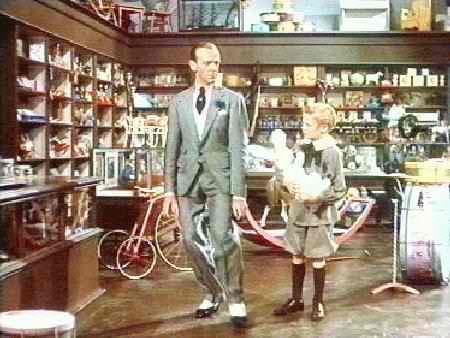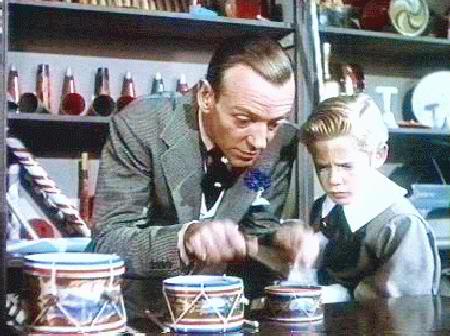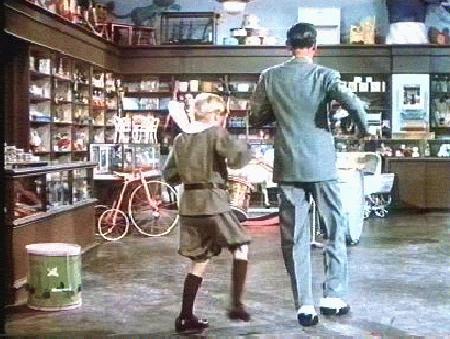
Boys' Clothing in Movies: Easter Parade, (United States, 1948)

Figure 1.--In one scene from "Easter Parade" as Don Hewes (Fred Astaire) sings the Irving Berlin number "Drum Crazy". The scene is set in a gift shop where Astaire meets a rather defiant boy clutching a stuffed Easter bunny that Don wants for his sweetheart. The boy played by Jimmy Bates, wears a tunic suit with a large Eton collar and floppy bow.
|
This is one of those films that is interesting to HBC because of one scene. The plot line is rather thin. The film is of course a vehicle Fred Astaire's dances routeins and Judy Garlans's singing. In one scene as Astaire sings the Irving Berlin number "Drum Crazy", he is watched by a bemused youngester clutching a toy Easter bunny. The boy later joins Astaire, marching in time and banging a toy drum. The movie is set in the years before World War I (1914-18) and the boy is wearing an outfit of a short belted tunic with floppy bow tie, large Eton-style collar, and knickerbockers. The knickers are above the knee and worn with kneesocks. These tunic suits including above the knee knickers were a popular fashion before World War. Wearing knickers with kneesocks, however, was more common for a brrief period from about 1915 to the early 1920s. HBC is not precisely sure about the time line, but notes that most boys wore long stockings or three-quarter socks with these tunic suits before World War I.
Filmology
"Easter Parade" was directed by Charles Walters. The film is of course a vehicle Fred Astaire's dances routeins and Judy Garlands's singing. The film is one of Garland's best at MGM. It was a dazling production, perhaps a bit thin on plot, but with an wonderful cast and elaborate, generally historically accurate costumes. The music and dancing are superb. Thre film is especially notable for Garland, who was mostly known for her singing, matched Astaire in several intricate dance numbers.
Easter
Easter is a religious holiday, the most important on the Christian callendar after Christmas. This film does not touch on Easter as a religious holiday. Easter also has fashion connotations. Easter coincides with Spring. A a result, it is a time that men a women got new clothes to wear as they put away their winter clothes. The Easter Parade was a parade up New York's Fifth Avenue where women in particular showed thir new Sping hats and dresses. Fifth Avenue is of course America's most famed street for shopping and fashion. Easter was also a time to buy a new Spring outfit for boys and girls. hese wre dress outfits suitable for attending church. Newspapers in the weeks leading up to Easter arevfull of advertisements for new Spring suits and other outfits. The connection with Easter in this film is the famous New York Easter parade.
Cast
The movie starred Fred Astaire and Judy Garland. I'm not sure who played the part of the boy in the toy store dance scene, but I think he is Jimmy Bates.

Figure 2.--The boy is at first bemused with Don (Astaire) and his dancing, but later joins him, marching in time and energetically banging a toy drum. The boy's tunic suit has above the knee knickers which he wears with kneesocks.
|
Plot
The plot line is rather thin, but provides the opportunity for multiple song and dance numbers. Dancers Don Hewes (Fred Astaire) and Nadine Hale (Ann Miller) are a popular Vaudeville dancing team. Hale is, however, nit satisfied and decides to start our on a career on her own. She tells Don the day before Easter in 1911. He is crushed when he learns that Nadine, who he loves, will not sign a new contract with him. Piqued with Nadine's rejection to pursue a solo career, Don rather arrogantly declares that he could turn any chorus girl into a star. He needs a new partner and takes the first prospect that comes along, Hannah Brown (Judy Garland). Don vows to make his innocent new partner a star in time for next year's Easter Parade, reffering of course to New York's famed parade up Fifth Avenue. This rather reminds one of George Bernard Shaw's Pygmallion. The new team proves so successful, that famed Broadway promoter Florence Ziegfeld expresses an interest. Don refuses the offer as Nadine dances in the Ziegfeld Follies. Don falls in love with Hannah. but is determined to keep their relation strictly professional. Hannah who has also fallen for him concludesis, however, that he is still in love with Nadine and her opinion is confirmed when he dances with Nadine in a Night Club Floor Show.
Important Scene
This is one of those films that is interesting to HBC because of one scene. At the beginning of the film, Don is choosing Easter gifts for Nadine. He decides on a stuffed bunny, the only problem is that a little boy has also set his sights on the bunny and is most displeased with Don tries to get t from him. Astaire, in an effort to distract the boy and interest him in toy drums, sings the Irving Berlin number "Drum Crazy" in a dance sequence. He is at first watched by the bemused youngester still clutching the contested stuffed Easter bunny. The boy later joins Astaire, marching in time and enthusiastically banging a toy drum.

Figure 3.--Here Don (Astaire) attempts to interest a skeptical boy in toy drums instead of the contested bunny. The boy is soon enthusiastically joining Don, marching in time and energetically banging a toy drum. Notice the boy's large Eton collar. Rounded Peter Pan collars were also worn with tunic suits.
|
Setting
The movie is set in New York in 1911, a few years before World War I (1914-18).
Costuming
The boy is wearing an outfit of a short belted tunic with floppy bow tie, large Eton-style collar, and knickerbockers. The knickers are above the knee and worn with kneesocks. These tunic suits including above the knee knickers were a popular fashion at the turn of the century before World War. They were commonly worn with above the knee bloomers rather than heavier full knickers as pictured in the film. HBC is not sure how common weaing knickers with knnesocks was before the War. Wearing knickers with kneesocks, seems to have been more common for a brrief period from about 1915 to the early 1920s. HBC is not precisely sure about the time line, but notes that most boys wore long stockings or three-quarter socks with these tunic suits before World War I. This is a topic we hope to persue in more detail. While the boy's costume looks pretty convincing, Astaire's own dress in the scene looks a bit modern for the period (pre-1914).
We've noticed that many 1940s Hollywood musicals set in the the ragtime
years have a similar free interpretation of what constitutes authentic
costume of the period.
HBC Clothing Inormation
HBC has collected some information on the garments worn by the boy in the dance scene discussed here.
The Eton cllar was widely worn by American boys in the late-19th and early 20th centuries for generally dress-up outfits. Often younger boys wore lace and ruffled collars and older boys Eton collars, but we have seen quite young boys wearing Eton collars as well.
Large floppy bows were very popular for boys, at least with their mothers from the 1880s through the early 1900s. They were often worn with lace or ruffled collars. We have noted them worn with Eton colars as well. Boys often wore Eton collars wihout bows or even ties, but younger boys often wore them with floppy bows in the years bfore World War I.

Figure 4.--The boy with the toy drums eventually enthusiastically enthusiastically joins in the dance routien. Note the above-the-knickers.
|
Tunics suits seem to have been particularly popular in America. Three styles were generally worn. The sailor style was the most popular, but the Russian blouse and Buster Brown styles were also popular. These tunic were mostly worn with above the knee knickers and short pants. A relate style, the Russian blouse suit was
occasionally worn with long pants--mostly in the long pants variant.
Knickers were intially pants buckling below the knee. They were not initially intended for little boys who were normally outfitted n dresses. Outfits for somewhat older boys could be worn with a variety of outfits. Tunics were worn throughout much of the 19th century. Younger boys might wear them with pantalettes or when
pantalettes went out of style in the 1870s, with knickers. Other outfits such as sailor suits, Russian blouses, and Buster Brown outfits could be worn with knickers or knicker-like bloomers. As these outfits were mostly for younger boys, by the late 19th century, they were often worn with above the knee knickers and long stockings. As the turn of the century children might wear them with ankle socks or go without stockings. After the turn of the century, knee socks became more
common.
It was much more common for American boy to wear long stockings with above the knee knickers. For a few years, however, we have noted that some boys wore kneesocks with above-the-knee knickers.
Christopher Wagner

Navigate the Boys' Historical Clothing Web Site:
[Return to the Movie "Ea-El" alphabetical page]
[Return to the Main movie page]
[Return to the Main movie holiday page]
[Introduction]
[Activities]
[Biographies]
[Chronology]
[Clothing styles]
[Countries]
[Theatricals]
[Bibliographies]
[Contributions]
[FAQs]
[Glossaries]
[Satellite sites]
[Tools]
[Boys' Clothing Home]
Created: April 1, 2002
Last updated: April 3, 2002






